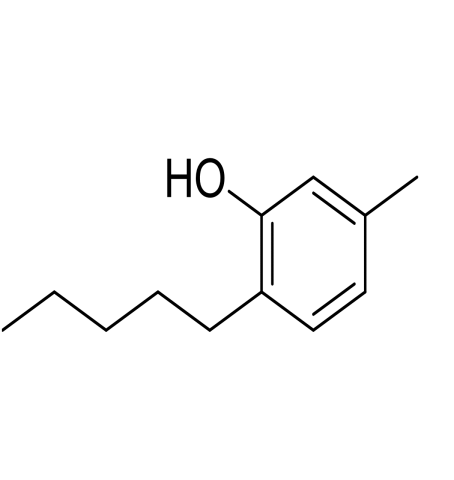Amylmetacresol is an antiseptic commonly used in over-the-counter throat lozenges, notably as a key ingredient in Strepsils since their introduction in 1958. Derived from m-cresol, it works by eliminating bacteria and viruses in the mouth and throat, helping to relieve symptoms like sore throat. It is often combined with 2,4-dichlorobenzyl alcohol to enhance its antimicrobial effectiveness and treat minor infections.
Brand Names
Strepsils: This is one of the most well-known brands and comes in a variety of flavors and formulations, including those with combinations of amylmetacresol and dichlorobenzyl alcohol.
Cepacol: The Canadian versions of Cepacol Sensations lozenges use amylmetacresol in different flavors.
Cofsils: This brand includes lozenges with a combination of amylmetacresol and 2,4-dichlorobenzyl alcohol.
MECHANISM OF ACTION
The exact mechanism behind its virucidal action is not yet fully understood. However, it is believed to involve processes such as the denaturation of viral surface protein spikes, pH-induced structural changes in viral attachment proteins, or a targeted effect on viral lipid membranes and protein–lipid interactions. Amylmetacresol acts as both an antibacterial and antiviral agent, and it also blocks voltage-gated sodium channels in a manner similar to local anesthetics.
PHARMACOKINETICS
Absorption: When administered through lozenges or sprays, amylmetacresol is absorbed locally in the mouth and throat.
Distribution: Amylmetacresol is an antiseptic agent primarily distributed as an ingredient in over-the-counter (OTC) throat lozenges and oral antiseptics.
Metabolism: After absorption, it is rapidly oxidized into a carboxylic acid.
Excretion: This carboxylic acid is then glucuronidated and promptly excreted by the kidneys.
PHARMACODYNAMICS
The pharmacodynamics of amylmetacresol involve both local anesthetic and antiseptic effects, helping to relieve sore throat pain and reduce viral infectivity. It exerts its anesthetic action by blocking sodium channels, similar to local anesthetics, and its antiseptic properties enable it to kill bacteria and viruses. The antiviral effect is believed to result from disruption of viral proteins or lipid membranes, although the exact mechanism is still under investigation.
ADMINISTRATION
Amylmetacresol is typically administered orally in the form of a lozenge to treat mouth and throat infections. It is available over-the-counter and often combined with other antiseptics like 2,4-dichlorobenzyl alcohol for enhanced effect. Before using amylmetacresol, it's important to consult a healthcare professional, particularly if you have any underlying medical conditions or are taking other medications. The following information is intended for general knowledge and should not replace professional medical advice.
DOSAGE AND STRENGTH
Amylmetacresol is most commonly available in lozenge form for the treatment of sore throat and minor mouth or throat infections. It is usually combined with 2,4-dichlorobenzyl alcohol in over-the-counter formulations.
Typical Strengths:
Amylmetacresol 0.6 mg per lozenge
2,4-Dichlorobenzyl alcohol 1.2 mg per lozenge (when in combination)
Usual Adult Dosage:
One lozenge every 2–3 hours, as needed
Maximum daily limit: Follow specific product labeling; generally, do not exceed 8–12 lozenges per day, depending on the brand and formulation
DRUG INTERACTIONS
Based on available medical literature, there are no known significant drug interactions for amylmetacresol when used alone in its antiseptic capacity for treating minor throat and mouth infections. The situation changes when amylmetacresol is combined with other active ingredients, which is common in over-the-counter sore throat lozenges. Any potential interactions typically arise from the other ingredients, not the amylmetacresol itself.
FOOD INTERACTIONS
Amylmetacresol itself does not have any known specific food interactions. However, some lozenge formulations containing amylmetacresol may include sugars such as glucose or sucrose, which should be used with caution by individuals with diabetes. To help reduce throat irritation, it is also advisable to avoid spicy or acidic foods while using these lozenges. If amylmetacresol is included in a combination product, additional interactions may apply—for example, if combined with dextromethorphan, it's best to limit caffeine intake, as it may worsen symptoms like a dry cough.
CONTRAINDICATIONS
The primary contraindication for amylmetacresol is a known allergy to the active ingredient or any other components in the formulation. Caution is also advised in certain groups, including young children, pregnant or breastfeeding women, and individuals with specific medical conditions, who should avoid its use unless directed by a healthcare professional.
SIDE EFFECTS
Mild irritation or a burning sensation in the mouth or throat
Tongue soreness
Dry mouth, especially with excessive use
Mild numbness or a tingling/stinging sensation in the mouth
Digestive discomfort, such as nausea or indigestion (dyspepsia).
OVER DOSE
An overdose of amylmetacresol, typically found in throat lozenges, is unlikely to cause serious harm but may result in gastrointestinal discomfort. However, if the lozenges contain other active ingredients, a significant overdose could pose greater risks and would require immediate medical attention.
TOXICITY
Amylmetacresol has low toxicity, with an LD50 of 1500 mg/kg in rats. However, it can cause side effects like tongue soreness. If swallowed in large quantities, it may lead to nausea, vomiting, and stomach discomfort. At high concentrations, it is corrosive, potentially causing severe skin burns and eye damage. Additionally, it is highly toxic to aquatic life. Amylmetacresol is not recommended for children under 3 years old, and pregnant or breastfeeding women should consult a healthcare provider before using it.

